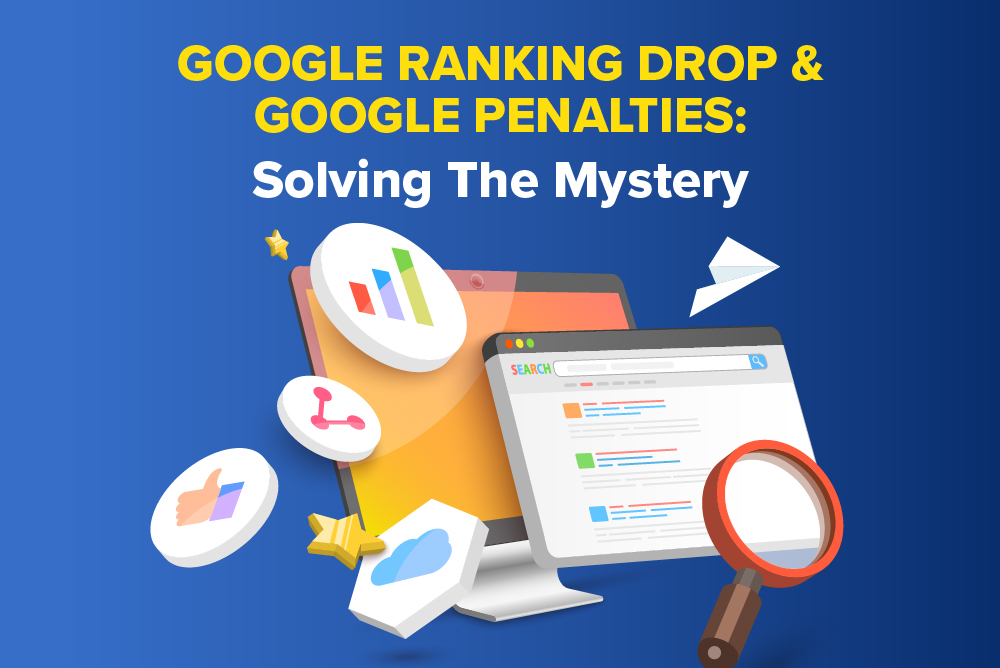Backlinks have long being a staple SEO ranking factor within Google Search’s algorithm. Naturally, as marketers, we all want to build backlinks so our sites will rank higher in search engines, get more organic traffic, and generate more sales. But are you sure that the links you’ve built are of high quality?
You’ve got to be sure that these links aren’t putting your site at risk for getting penalized and unable to rank. That’s why it is important to check the quality of every backlink you have. Successfully assessing your backlinks means knowing which metrics matter, how they should be interpreted, and what can compromise their value.
In this article, we will explore the importance of backlink quality and several key metrics to check any backlink for.
Why Backlink Quality Matters
Backlinks are links from other websites to yours, and they are one of the most important factors in ranking a website in search engine result pages (SERPs). Quality backlinks send trust signals to search engines that the linked-to website is valuable and should rank higher. Having high quality backlinks will help improve your rankings and boost your visibility online.
However, low-quality or spammy links can harm your website’s reputation and rankings. Generally speaking, low-quality backlinks are created with the purpose to manipulate search engine rankings and have a negative effect on your performance. This means that any backlink has the potential to backfire.This is why consistent link audits need to be used during the course of implementing your SEO strategy.
Algorithm Penalties For Spammy Links
Algorithm penalties for spammy links are measures taken by search engine algorithms to identify and penalize low-quality websites attempting to manipulate their ranking through low value links.
Google first implemented its Penguin algorithm in 2012 as a way to deal with websites that had built up a significant number of spammy links. The Penguin algorithm penalizes websites by removing them from the search engine index or reducing their rank. This can be especially damaging for businesses and organizations whose livelihoods depend on organic search traffic.
Following the Penguin algorithm, Google has further enhanced its spam link detection through further link spam updates. This helps to deter black hat link building practices and thus improves the general quality of search results.
It is important to remember that Google does not consistently publicly disclose its algorithm changes. This means that any penalties can come as a surprise to websites that have unknowingly built up a significant number of spammy links. That’s why it’s important to stay vigilant and constantly be assessing the quality of your backlinks.
Website Backlink Profile Metrics
Domain Authority/Domain Rating
Domain Authority (DA) and Domain Rating (DR) are metrics used to measure the quality of a website’s backlink profile. These metrics assess the overall quality of a website’s links, taking into account factors such as backlink authority, link diversity, and more.
DA and DR essentially mean the same thing, and serve as proxies as to the strength of a website. They are a surface level backlink metric that marketers first refer to when assessing the value of a link. Broadly speaking, the higher the DA/DR, the safer and more impactful a link from the website will be.
DA/DR is measured on a scale from 0 to 100, with higher scores indicating stronger backlinks. If the website has a low DA/DR, it is likely that the link won’t be as effective and may even be considered spam. In this case, it would be wise to avoid getting a link from the website.
Page Authority/URL Rating
Page Authority (PA) and URL Rating (UR) are metrics used to measure the quality of a specific web page’s backlink profile. These metrics assess the overall quality of a particular web page’s links, taking into account factors such as backlink authority, link diversity, and more.
A common mistake made for SEOs new to link building is to only rely on DA/DR for assessing the quality of an incoming backlink. The issue here is that the page in question where the link is coming from may not be receiving much internal backlinks from the website and thus not provide a strong boost to your website.
Additionally, if your backlink is on a brand new page, then chances are that it will have a low PA/UR.
Trust Flow
Trust Flow is a metric used to measure the trustworthiness of a website’s backlink profile. The score is measured on a scale of 0-100 and takes into account factors such as the number of external links pointing to the page, the authority of those external links, and how relevant they are to the content on the page.
While similar to Domain Authority, Trust Flow is a more focused metric. Unlike DA, TF solely refers to the quality of links pointing to a website. It measures the trustworthiness of these links based on the quality and authority of the sites that are linking to the website in question. The more high-quality and trustworthy websites that link to a site, the higher its backlink trust flow will be.
As covered earlier, DA is different here as it takes into account a wide variety of factors, including the quality of the content on the site, the number and quality of backlinks pointing to the site, the age of the site, and more.
Spam Score
Backlink spam score is a metric that indicates the potential spamminess of a website. It is a score assigned by SEO tools to help website owners and SEO professionals determine the quality and safety of their backlinks.
Measured as a percentage, backlink spam score is dependent on several factors, many of which are covered in this blog. Examples include:
- Low-quality websites: If the website has thin content, high bounce rates, or a lot of ads, it may be considered spammy.
- Suspicious link patterns: If a website has a large number of backlinks that all have similar anchor text or are coming from the same IP address or domain, it may be considered spammy.
- Malware or viruses: If a website is found to be hosting malware or viruses, it may be considered spammy.
A higher spam score indicates a higher likelihood that the backlink is spammy and could harm a website’s SEO performance.
Spikes In Backlinks
Spikes in backlinks can be indicative of link building manipulation and should be monitored. If you notice that a website suddenly has an influx of backlinks from low-authority websites or websites with suspicious link patterns, then it could be a sign of malicious link building tactics and should be investigated further.
Additionally, if you notice that a website has a sudden drop in backlinks, then it could be due a previous bunch of low quality links being dropped. In either case, websites that have sudden spikes in backlinks should be avoided for the time being.
Do note that all metrics here are for external incoming backlinks and not internal linking. For internal linking best practices, a separate set of guidelines apply since its all within your own website.
Website Backlink Ratios
Anchor Text Ratio
The anchor text ratio is a metric that can be used to evaluate the quality of a website’s backlink profile. It is the ratio of exact match anchors (keywords) versus generic or branded anchors. A good anchor text ratio is around 40-60% brand anchors or naked anchors, while the remaining amount can be exact or partial matches. If the website in question has an overwhelming percentage of money keyword or spammy anchor texts, then the quality of links from it might be poor.
CCTLD Link Ratio
The CCTLD (Country Code Top Level Domain) link ratio measures the ratio of links from domains with different country codes in their TLDs (e.g. .uk, .de, .fr etc.) along with generic domain extensions. If a website receives too many links from a CCTLD that does not match their locality, then it can be viewed as suspicious.
Follow No-Follow Link Ratio
The follow to no follow link ratio looks at the percentage breakdown between these 2 types of links. In general, it would be safer to have at least 40% of of a website’s backlinks as no-follow links. This is due to the more broad usage of no-follow links.
Other Website Metrics
Ensuring That Hosted Servers Are Different
It is important to ensure that the websites hosting your backlinks are all on different servers. This can be easily checked using tools such as WHOIS Domain Lookup, which displays information about a domain’s server IP address. If two linked websites are hosted on the same server, it could be seen as suspicious by search engines and may negatively impact your website’s SEO performance.
Organic Traffic
Organic traffic is one of the most important indicators of backlink quality because it measures how much real people are engaging with the potential linking website. This is perhaps one of the most important indicators for backlink quality as it acts as a proxy for the value of the website. Additionally, having a good stream of organic traffic into the website increases the possibility of referral traffic coming to your site via the backlink.
Relevance Of Linking Website Niche
The relevance of the linking website’s niche is also an important factor to consider when evaluating backlink quality. If a website has links coming from other websites in its own industry, then these links can be considered more valuable than if they are coming from unrelated industries.
Anchor Text Used In The Link
Anchor text is the clickable text used to link from one page to another. It is an important factor when evaluating backlink quality as it can provide context and relevance for the link. An ideal anchor text should be descriptive, relevant to the linking website’s content, and contain selected keywords or brand terms that are related to your website’s industry.
Use Tools To Check For Backlink Quality
There are several SEO competitor analysis tools available to help you check the quality of backlinks. Since each of these tools attempts to mimic Google’s search algorithm, their analysis of backlinks do tend to differ slightly. In fact, several of the metrics covered above are not available across all tools. As such, ideally you would have at least 2 SEO backlink tools to cross reference against each other.
Moz Link Explorer
Moz Link Explorer is a powerful SEO tool that can be used to assess the quality of backlinks. It will provide you with an in-depth analysis of a website’s backlink profile and offer insight into which websites are providing the most value. Additionally, it offers metrics such as Domain Authority, Page Authority, Spam Score and MozRank.
Ahrefs Site Audit
Ahrefs Site Audit is an SEO tool that allows users to perform a comprehensive audit of a website’s backlinks. It will provide detailed information about the quality and quantity of the website’s links, as well as potential issues with its link profile. Ahrefs Site Audit also identifies any suspicious or low quality links that could be hampering the website’s SEO performance.
Semrush Domain Overview
Semrush Domain Overview is a comprehensive tool that can be used to assess the quality of a website’s backlinks. It will provide detailed information about the total number of links, anchor text distribution, and link types such as do-follow and no-follow. Additionally, it offers metrics such as domain trust score, domain authority, and link diversity.
Majestic Site Explorer
Majestic Site Explorer is a powerful tool that can be used to assess the quality of backlinks. It provides users with in-depth analysis of a website’s backlink profile, offering metrics such as citation flow, trust flow and domain score. Additionally, it offers further insight into link types such as do-follow and no-follow.
Conclusion
All in all, backlink quality is an important factor when it comes to SEO performance. It is essential to ensure that your website’s backlinks are of high quality and come from reputable websites with a good stream of organic traffic. Given how sophisticated and punishing search algorithms have become, extra care needs to be taken to ensure a clean link profile.
We should also caution that backlinks are not the end all be all in SEO. Rather there are several other types of SEO that need to be utilised on your website as well.
In need of a backlink audit or comprehensive SEO services? Speak to First Page Digital’s SEO strategists today to find areas for improvement in your backlink strategy. Our SEO specialists are up to date with the latest backlink building strategies and have access to a wide suite of backlink audit tools.
![How To Check Backlink Quality [SEO Guide]](https://www.firstpagedigital.sg/wp-content/uploads/2023/03/Backlink-Metrics-Measuring-the-Value-Of-A-Backlink.jpg)
















